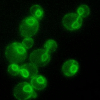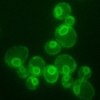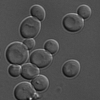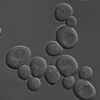 NOTICIAS
NOTICIAS
A new quality control pathway in the cell
- In a paper published today in Science, CRG researchers describe a new protein quality control system in the inner nuclear membrane.
- The new system has two main functions, to eliminate misfolded proteins and to protect the nucleus from accumulating mislocalised (or ectopic) proteins. This may be especially relevant in non-dividing cells such as neurones.
Proteins are important building blocks in our cells and each cell contains millions of different protein molecules. They are involved in everything from structural to regulatory aspects in the cell. Proteins are constructed as linear molecules but they only become functional once they are folded into specific three-dimensional structures. Several factors, like mutations, stress and age, can interfere with this folding process and induce protein misfolding. Accumulated misfolded proteins are toxic and to prevent this, cells have developed quality control systems just like any other production chain or manufacturing process.
A team of researchers at the Centre for Genomic Regulation in Barcelona has just published a paper in Science describing a new quality control system in our cells. It is specific to the inner nuclear membrane, a specialised part of the endoplasmic reticulum (ER), a network of membranes that spreads throughout the cell and which also forms the nuclear envelope that wraps the chromosomes.
Other quality control systems have been described but exactly how misfolded proteins in the inner nuclear membrane were degraded was not known. Ombretta Foresti, Victoria Rodríguez-Vaello and Pedro Carvalho, from the Organelle Biogenesis and Homeostasis laboratory at the CRG have just described the new system. “We have found that this quality control system has two key functions. It gets rid of misfolded proteins and, surprisingly, it also helps prevent the nucleus accumulating proteins that should not be there”, explains Pedro Carvalho, principal investigator of this paper.
The studies have been conducted using a unicellular model organism (Baker’s yeast) but they may also apply to human physiology. The newly identified quality control system protects the nucleus by targeting foreign proteins that could enter the nucleus by mistake. This could be particularly significant in non-dividing cells where the inner nuclear membrane is isolated from the rest of the ER for long periods of time
These findings have been made possible thanks to funding from the Howard Hughes Medical Institute (HHMI) and MCCIN at the CRG in Barcelona.
Reference paper: Ombretta Foresti, Victoria Rodríguez-Vaello, Charlotta Funaya and Pedro Carvalho. “Quality control of inner nuclear membrane proteins by the Asi complex”, Science (2014). DOI: 10.1126/science.1255638
| Adjunto | Tamaño |
|---|---|
| 314.96 KB | |
| 319.37 KB |





